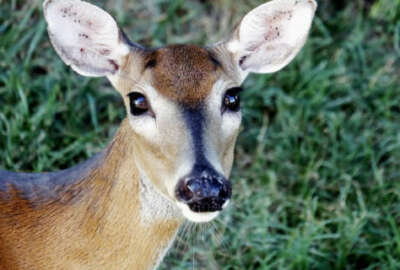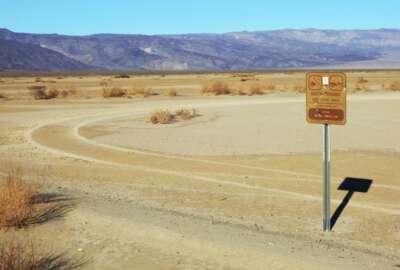
How the National Park Service controls the size of its picturesque bison herd
In the Grand Canyon National Park, the growing bison herd has to be controlled and park staff have several ways to do that, with help from sharp-shooting...
Best listening experience is on Chrome, Firefox or Safari. Subscribe to Federal Drive’s daily audio interviews on Apple Podcasts or PodcastOne.
From rattlesnakes to bison, the wildlife are part of the attraction in places like the Grand Canyon National Park. But it’s 2021, not 1821, and the bison herd has to be controlled. That’s why the National Park Service has initiated what it calls a lethal reduction to explain how it works, spokesman Kait Thomas.
Interview transcript:
Tom Temin: Ms. Thomas, good to have you on.
Kait Thomas: Great to be here, thank you so much for having me.
Tom Temin: And I was going to ask you how come you’re having a bison hunt? And you were going to tell me it’s not a hunt, is it?
Kait Thomas: That’s right. And I’m really glad that you asked this question. So “hunt” is a misnomer. And once the Park Service announced that we were lethally removing or culling bison from the park, the the term hunt caught fire. But that couldn’t really be further from what’s actually happening. And lethal removal, as this is called, it differs from a hunt in purpose, manner and disposition. So the purpose of this removal is not recreational at all. It’s a management activity with the goal of reducing the population of overpopulated or destructive animals, and in this case, bison.
Tom Temin: And what is it about the bison that requires them to be called?
Kait Thomas: Well as for why we’re doing this, we’ll need to travel back in time a little bit. So the herd of bison that was introduced near the North Rim of Grand Canyon in the early 1900s eventually drifted down to the end of house rock Valley and the state of Arizona began managing this herd back in 1929. And today, this herd has expanded to about three to 500 individuals. But starting in the 1990s, a combination of wildfires, drought, and hunting in the area drove the bison into the North Rim of Grand Canyon, where they have ranged in a very small area almost exclusively since 2009. So these bison have a particularly high impact on the ecosystem, because this ecosystem is not recently adapted to large-scale bison grazing. So the bison here are trampling the soils, they’re decimating native plants, they are polluting very fragile water resources, and they even damage irreplaceable archaeological sites. And if I could show you photographs, you can see that parts of the park have just been so trampled that areas that were once really lush valleys have become pockmarked with dust pits and mud holes. And now we have invasive plants on the rise and E. coli contamination from the bison is affecting the North Rim aquifer which, thousands of people depend on every year.
Tom Temin: Sure, and I guess the National Park Service has plans for a little bit more development for tourists on the North Rim also going on.
Kait Thomas: While we’re certainly looking into redoing our waterline. And so this is a big part of that. We want to be able to accommodate the large number of visitors. Visitation – I know we’re still in a COVID year, but visitation is increasing from last year. And we expect it to get back up to where it’s been in the previous few years and increase from there. So we’re certainly looking toward making sure our infrastructure is prepared to handle those visitors.
Tom Temin: So you don’t want zero bison and you just want a manageable number that can live in harmony with that North Rim.
Kait Thomas: Right, exactly. So if we did nothing, this bison herd could grow to about 1,500 individuals over the next 10 years and they’re already too many. Five hundred bison in such a small location is really going to just take out the ecosystem. And if no management action is taken, it might even be detrimental to the herd itself for it to grow that large. So in 2017, we conducted an environmental assessment that determined that the herd size should be about 200 animals in order to be in balance with the ecosystem. And the public was allowed to provide comment during this period of time, we received lots of public comments, lots of folks that were for the program and just a few who were against. And in the end, the Park Service, the state of Arizona, the Forest Service, we developed a system of reducing the herd through a multi-pronged approach. So we’re doing live capture and relocation as well as lethal removal. And so lethal removal is only a small part of what we’re doing to manage the bison. So far, we’ve been really successful with live removal, too. So over the last two years, 88 bison have been successfully captured and relocated to the InterTribal Buffalo Council, and they were then distributed to several Great Plains tribes from that agency. And we will continue our partnership with them this fall.
Tom Temin: And so my question then is if this culling by lethal reductions is required, why have members of the public apply for the licenses or the permits to do the shooting? Why not just have park personnel handle it – 1, 2, 3?
Kait Thomas: Yeah, and that’s a great question. And I’ve gotten that question a lot. And the answer really is waste. So the National Park Service as a federal agency, we cannot just donate meat or parts to individuals directly. It has to be a government-to-government thing. So by having volunteers come in and assist, we then will have them legally remove the bison, the bison carcasses will be donated to the state of Arizona, and then the state of Arizona will distribute the meat, the parts to those volunteers. And surplus meat will go to our 11 traditionally associated tribes, and they have expressed significant interest in receiving meat from us. So by doing it in this manner, by having the public volunteers were able to donate those meat in parts where otherwise we wouldn’t necessarily be able to do so.
Tom Temin: Some good bison burger coming up here we’re speaking with Kait Thomas. She’s an acting public affairs specialist at the Grand Canyon National Park. And I say you are one of the luckiest people to work on one of God’s great spots here in North America. And how do you then assess the skill and ability of the people that will do this to make sure that they do it quickly, humanely, and competently?
Kait Thomas: Right. So the applicants, once we received the finalists, the applicants who will be given a federal background check, and they must show proof of a hunter safety certificate. We’re also going to be interviewing them, so we’ll have a team of park officials. And we’ll be asking about their big game experience in this interview, vetting them making sure that they do know what they’re doing. And once we’ve narrowed down the candidates to the best 12, each of the 12 final applicants will be required to pass a shooting proficiency test at the park before the operational period begins. So they’ll need to be able to get three out of five shots in a four-inch target at 100 yards.
Tom Temin: Some serious shooting skill.
Kait Thomas: Absolutely.
Tom Temin: And do you have any idea of what it takes in terms of caliber to bring down something as large as a bison?
Kait Thomas: Yes, so we are permitting only rifles chambered for bottlenecked cartridges with a bullet caliber of 30 caliber or larger combined with a nonlead bullet of 165 grains or heavier, and that’s all that we will be approving. We’re not going to make any exceptions and all of that ammunition must be lead free.
Tom Temin: Got it, yes you don’t want the missed shots or the lead in to the meat, I suppose. Because that’s – nobody wants lead. And is this going to be an annual event?
Kait Thomas: So this is a pilot event. It could become annual if it is successful, but we’re going to be taking a look at a lot of factors, you know, was this successful? Was it efficient? Was it timely? And do we think that we want to do this again. So if we do determine that this is successful, it could become an annual event. But it would only last for the duration of the five year agreement between the state of Arizona and the National Park Service. Before we would stop the program again and reassess. You know, we don’t want to remove too many bison, we want to make sure that we get it to that happy number of 200.
Tom Temin: And are you looking to, say, remove a certain number of males and females or can the shooters just pick whichever ones they can find?
Kait Thomas: So part of how this differs from the hunt is that we are going to be very specific. So the bison selected for lethal removal will be determined by management and every volunteer who will be with us will be accompanied by an NPS official at all times. So what they will do is they will actually identify that animal for its ability to most effectively reduce the reproductive potential of the herd. And generally, this means females of reproductive age, so we can’t guarantee that we won’t be removing a male or two. But for the most part, we’ll be looking at those females because that will most quickly reduce that reproductive potential. And the NPS official will identify the animal and then no more than one bison per volunteer will be removed. So we’re looking at a total of only 12 animals this year.
Tom Temin: So in other words is the resulting and leftover males won’t get overly frustrated next season.
Kait Thomas: I should hope not.
Tom Temin: And by the way, how does bison taste?
Kait Thomas: You know, I haven’t had a bison burger lately. But once upon a time when I lived up in Moab, Utah, I did enjoy some bison meatloaf.
Tom Temin: Alright, and bison are themselves vegetarian, correct?
Kait Thomas: I do believe so. I haven’t asked one lately.
Tom Temin: Well, you may get that chance. Kait Thomas is an acting public affairs specialist at the Grand Canyon National Park. Thanks so much for joining me.
Kait Thomas: Yeah, you’re welcome and thank you for having me.
Copyright © 2025 Federal News Network. All rights reserved. This website is not intended for users located within the European Economic Area.
Tom Temin is host of the Federal Drive and has been providing insight on federal technology and management issues for more than 30 years.
Follow @tteminWFED




